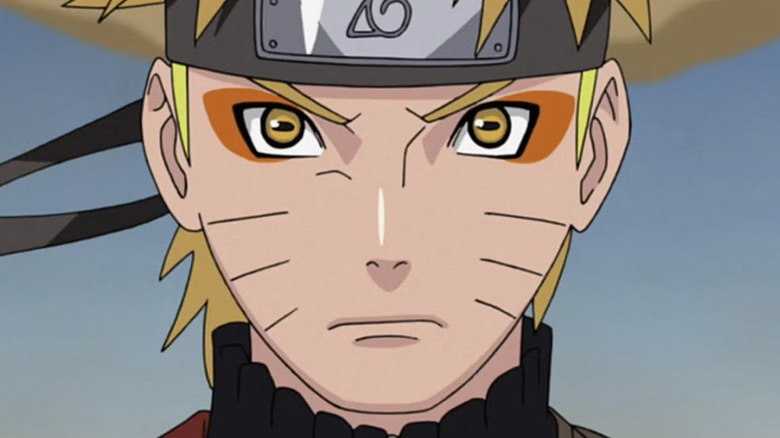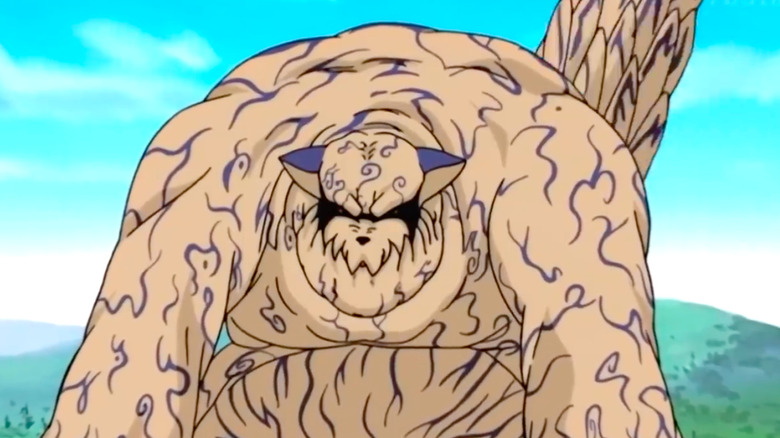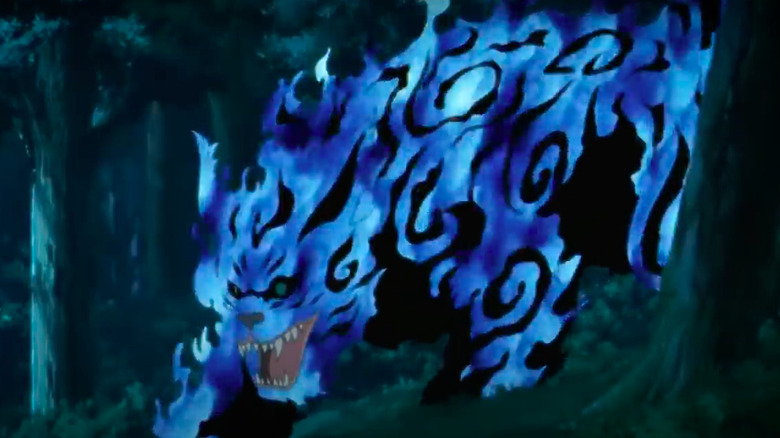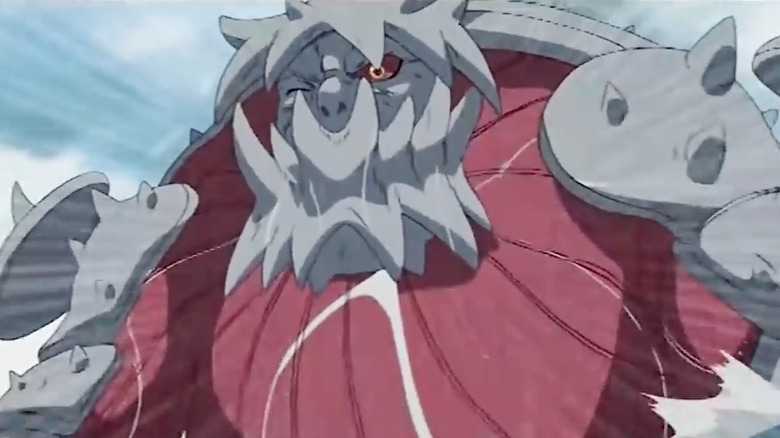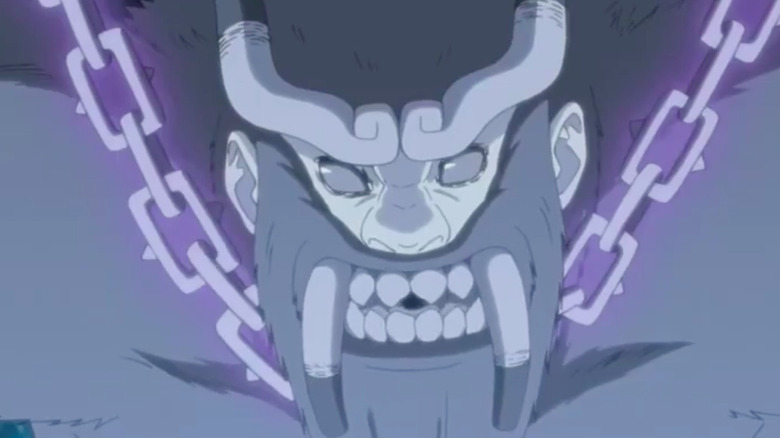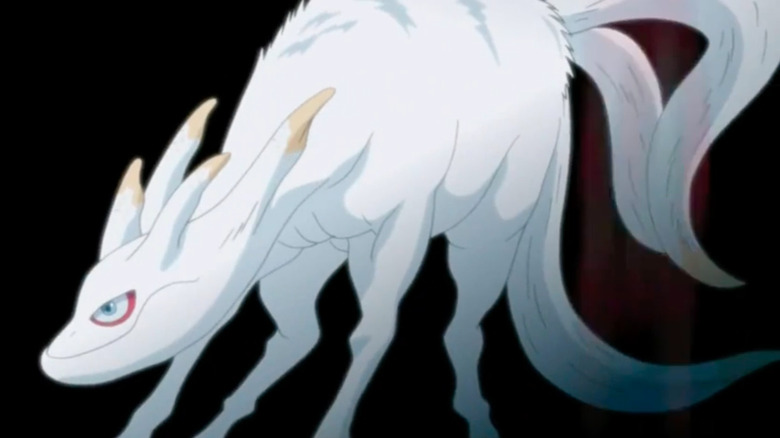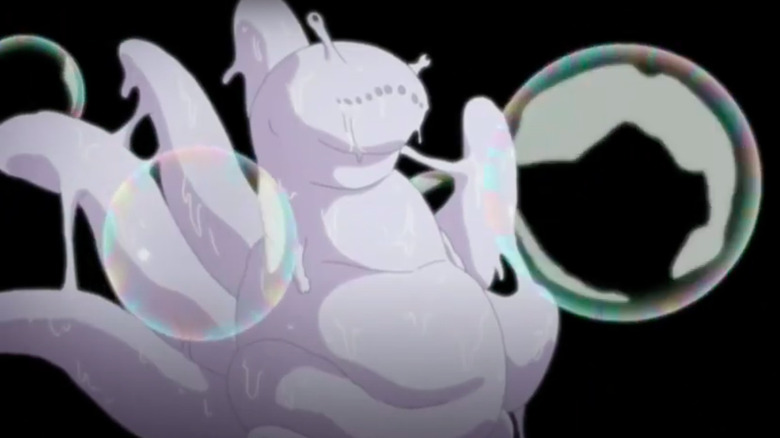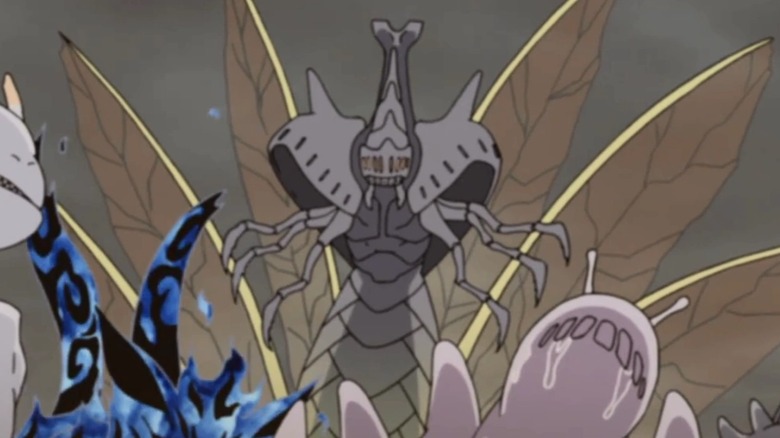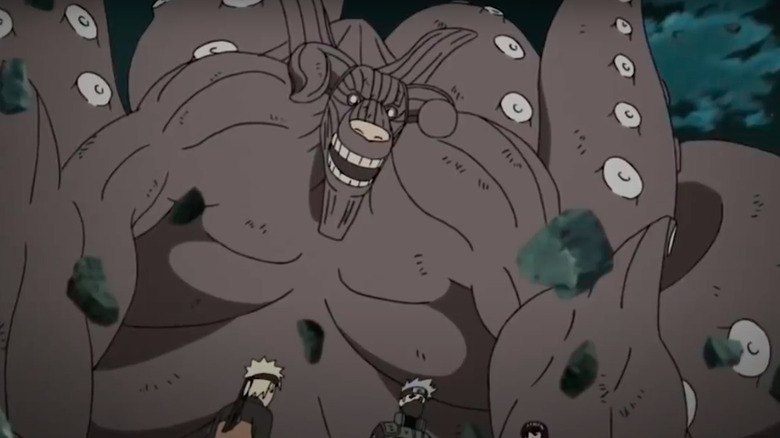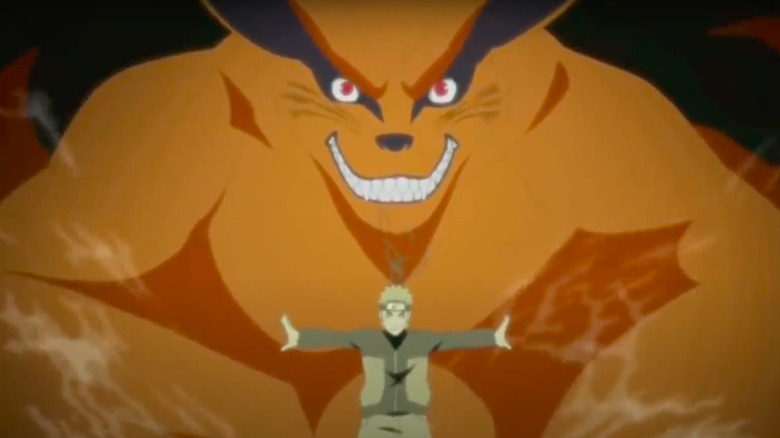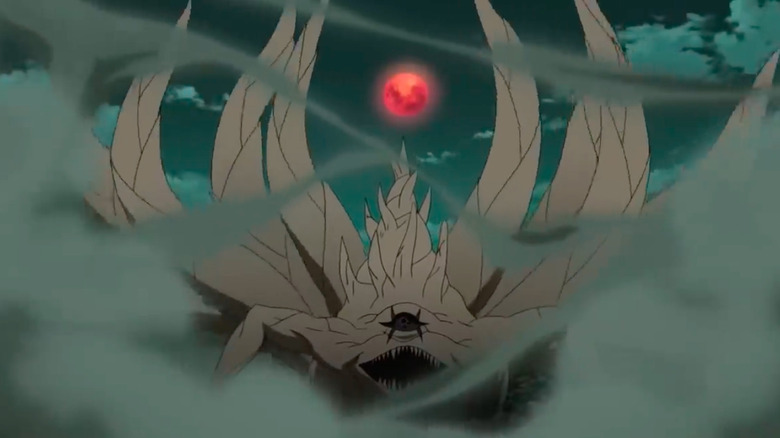Every Tailed Beast And Jinchuriki From Naruto Ranked Worst To Best
There are many chakra wielders in the world of "Naruto," but the powers within some shinobi are on another level. Those with the name of jinchuriki have an ancient and massive power sealed inside them — sentient chakra beings known as the tailed beasts. These beasts were created by the Sage of Six Paths long before Naruto and his friends were born and have been feared by humans for centuries.
In order to control the creatures they saw as rampaging demons, shinobi sealed each of the beasts within a human. The jinchuriki are able to communicate with the entities sealed away inside them, and sometimes they can even draw upon the beast's power to supplement their own. This can go wrong, however, and when it does, the beast may break out of its seal and attack anyone in its path.
There are nine tailed beasts in "Naruto," but do you know which one is the strongest? Each beast has a different number of tails ranging from one to nine, and it's said that the more tails they have, the more powerful they are. The designs of the tailed beasts match their strength too, as they have a deep connection to yokai, the Japanese demons of old mythology.
If you're struggling with all of the names, check out the Tailed Beast Counting Song that the anime released to help viewers remember the tailed beasts and their jinchuriki.
10. Shukaku
This sandy monstrosity known as the One-Tail is one of the first tailed beasts we meet in the anime, except Naruto, of course. Shukaku belongs to the Hidden Sand Village, and is sealed into the Fifth Kazekage, Gaara, while he is still in the womb. Shukaku's hatred towards humans greatly affects Gaara's childhood, as he repeatedly breaks free of his seal and rampages through the village.
Due to Shukaku's ability and threats to break free anytime Gaara sleeps, the young jinchuriki spends his formative years battling a severe case of insomnia. After Gaara becomes friends with Naruto, he eventually learns to control his tailed beast more effectively, and even improves their relationship.
Shuaku's design is inspired by the Japanese tanuki yokai, a shapeshifting version of the raccoon dog with a habit of playing tricks on humans. Unlike tanuki, Shukaku appears to be composed of sand, but you can see elements of the tankuki in his dark ears, the dark circles around the eyes, and his bushy tail. For reference, another famous tanuki in Japanese media is Tom Nook from the "Animal Crossing" video game series.
Shukaku's personality is proud, short-tempered and uncompromising, but he harbors an inferiority complex due to his standing as the bottom-ranked tailed beast. Despite his singular tail, Shukaku possesses superior defensive abilities compared to many of the other tailed beasts, such as the Ultimate Defense technique, which protects Gaara at all times.
9. Matatabi
The Two-Tails is affiliated with the Hidden Cloud Village, which doesn't have a close relationship with the Hidden Leaf Village. Owing to this, Matatabi doesn't get his first appearance in the anime until episode 72 of "Naruto Shippuden." We don't know very much of Matatabi's jinchuriki, Yugito Nii, as she falls victim to the Akatsuki soon after her debut. The evil troupe of shinobi overpowers Yugito even in her Two-Tail form and proceeds to extract Matatabi from her, a process that jinchuriki cannot survive.
Matatabi's appearance is inspired by the nekomata, a type of bakeneko (monster cat) yokai who often walk on their hind legs and make meals of humans. The mark of a nekomata is its split tail, or in other words, its two tails, which are often tipped with a blue flame. In Matatabi's case, his entire body is either engulfed in or made from blue flame, which he wields as his primary weapon.
In comparison to many of the other tailed beasts, Matatabi appears to have a quiet and respectful personality. He uses the proper Japanese personal pronoun, watashi, when referring to himself, and has even been seen using honorific language when speaking to humans.
Due to his affinity for fire, Matatabi uses Fire Release to create massive fireballs during battle. His cat-form also grants him superior speed and agility despite his enormous size.
8. Isobu
The Three-Tails is another tailed beast that makes a late debut, first appearing in episode 92 of "Naruto Shippuden," where he's living in a lake without a jinchuriki shortly before being captured and sealed away by the Akatsuki. Isobu is formerly affiliated with the Hidden Fog Village, where he was sealed inside the body of the Fourth Mizukage, Yagura Karatachi.
However, during his reign, Yagura is controlled by the powers of Obito Uchiha and manipulated into many cruel and murderous acts which completely destroy his reputation and legacy. Although Obito's control over him eventually breaks, Yagura dies soon afterward under unknown circumstances. After his death, it is thought that Isobu is reincarnated somewhere else in the world, perhaps in the lake where Naruto and the others found him.
Isobu's appearance is an amalgamation of sea creatures, most prominently the sea turtle. He has a hard, spiky shell with fleshy pink sections underneath. His arms and hands are also well-armored and spiked, and his right eye is constantly closed. His three tails are tough and shrimp-like in appearance. Although Isobu's physical appearance is not directly linked with any yokai, he shares his name with one. The sea creature yokai isonade and Isobu spell their name with the same Chinese characters: 磯, which means beach, and 撫, which means stroke.
Unsurprisingly, Isobu's main attacks involve water, and he makes use of Water Release frequently to create shockwaves and a hallucinogenic mist that plays on the insecurities of those it infects. Despite these monstrous abilities, Isobu's personality is timid and he uses the Japanese personal pronoun preferred by young boys to refer to himself.
7. Son Goku
Son Goku is the Four-Tails and goes by many names, including Seiten Taisei Son Goku, which means Great Sage Equalling Heaven, or King of the Sage Monkeys, or even Handsome Monkey King. One thing you should not call him, however, is the Four-Tails, as his proud nature detests this title that the humans have pushed on him.
In general, it means a lot to all of the tailed beasts to be referred to by their proper names, as it is a sign of their sentience and individuality which were taken away by the humans. Naruto only discovers that the tailed beasts have names in episode 329 of "Naruto Shippuden," during the Fourth Great Shinobi War.
Son Goku belongs to the Hidden Stone Village, and is last sealed within one of its shinobi, Roshi. This jinchuriki is unfortunately one of the people captured and killed by the Akatsuki during their mission to seal all the tailed beasts. The Handsome Monkey King's appearance is, unsurprisingly, that of a giant ape. He has red fur and green skin, with large fangs and even larger horns. Rather than being inspired by yokai, Son Goku is inspired by one of Kishimoto's favorite anime — "Dragonball Z." Not only does he share his name with the "Dragonball" protagonist, but his appearance is also inspired by the Saiyan Great Ape transformation. To top it all off, his jinchuriki is named after the "Dragonball" Son Goku's master and teacher, Roshi.
6. Kokuo
Like Son Goku, the Five-Tails also belongs to the Hidden Stone Village. Kokuo's jinchuriki, Han, also loses his tailed beast and his life to the Akatsuki. Before his death and during the Third Great Shinobi War, he's famous for his mastery of steam ninjutsu and wears large red steam armor all over his body and the bottom half of his face.
Kuokuo resembles a white horse with the head of a dolphin and has red markings under his eyes. This manner of red eye makeup in Japan is considered to signify power and dignity, and it is often seen in depictions of goddesses and geisha. It is said, however, to have originated with male kabuki actors who used it to signify strength. Kokuo's aura of majesty extends to his name: it's spelled with the Chinese character 穆, which means respectful and beautiful, and is used to spell an old adjective that means humble and dignified.
The Three-Tails also has a polite, reserved character, and he refers to himself with the formal pronoun, watakushi. In combat, Kokuo often uses the large horns on his head and combines Water and Fire Release to create Boil Release. This ability is what gives Han the power to use the steam ninjutsu he is famed for. His physical strength is not inferior to those with more tails, and he can even tackle the Eight-Tails and send him flying with his horns.
5. Saiken
The Six-Tails belongs to the Hidden Fog Village, and makes its debut in episode 151 of "Naruto Shippuden." His jinchuriki, Utakata, is a missing-nin from the Hidden Fog Village, meaning he has abandoned his duties and earned himself a death sentence. Utakata has a comparatively good relationship with his tailed beast – he's able to borrow his power without force and retain his consciousness while in full tailed beast form.
His unique soap bubble ninjutsu are created using a special bubble-blowing pipe which he keeps on him at all times, along with a flask of soap solution tucked inside his large, baggy kimono. Like many of the jinchuriki, he's captured by the Akatsuki and killed before Naruto has the chance to meet him.
Saiken takes the form of a gigantic slug and is covered in a layer of ever-dripping slime. Despite being a slug-type creature, he does have legs and arms, though both are quite stubby. His six long tails are just as slimy as any other part of him, as is his mouth, which seems to be partially glued shut with slime.
Water Release is Saiken's main affinity, and he can also use Utakata's soap bubble ninjutsu. His slimy slug body also seems to possess incredible durability, and he has even been thrown around by the Nine-Tails without injury.
4. Chomei
The Seven-Tails is both the only tailed beast to not be affiliated with one of the Five Great Shinobi Countries and the only one to have had a different form during his infancy. Chomei's appearance resembles a kabutomushi, or rhinoceros beetle, a popular insect in Japan. Six of his tails are depicted as insect wings, and the last one is an actual tail. The kabutomushi is so well-loved that it is chosen as a mascot for sports teams, and is coveted by every young bug catcher.
When kept as pets, they are often pitted against each other in beetle fights, a pastime that is depicted in many Japanese anime and other forms of media. Due to his bug-like form, Chomei appears to have a larval stage when he's young, during the Sage of Six Paths era.
The Seven-Tails' jinchuriki, Fu, is from the Hidden Waterfall Village, a shinobi village in an unnamed country. She is a young shinobi with tan skin and green hair, with a tomboyish and troublesome personality. She also uses typically male speech patterns.
Her ninjutsu are insect-themed, such as the creation of webs to heal her team members and cocoons to slow down chakra absorption techniques. These are ninjutsu she shares with Chomei, and she can use a partial tailed beast transformation to give herself Chomei's wings to fly. She is killed by the Akatsuki before the Fourth Great Shinobi War.
3. Gyuki
The Eight-Tails belongs to the Hidden Cloud Village, where it is sealed within the Fourth Raikage's brother, Killer B. Alongside Naruto and Gaara, Killer B is one of the only jinchuriki who evades capture by the Akatsuki. He is, however, attacked by them and escapes by allowing the Akatsuki to believe they had caught him while he disguises himself as one of Gyuki's severed tails. His village also believes him to be taken as he does not return after the battle, instead deciding to take a badly-timed vacation.
B has almost perfect control of Gyuki, and is able to shift in and out of a full tailed beast transformation without a problem. However, Gyuki's mature and headstrong personality often leads him to take charge of situations and attempt to boss B around. The two have such a deep bond that after the Fourth Great Shinobi War, Gyuki decides to return to B and be resealed within him.
Gyuki takes the form of an ushi-oni yokai, a type of ox demon. Both the names Gyuki and ushi-oni are spelled with the Chinese characters for "ox" and "demon", but are read differently. The ushi-oni is often portrayed with the head of an ox and the body of a spider or octopus, and they are savage yokai that eat humans. Gyuki himself has an ox's head and a large muscular torso, and his lower half consists of eight octopus-like tentacles.
Gyuki uses his immense strength, which can even restrain Kurama, alongside his lightning-fast tentacles when fighting. He can use them to create tornados or wrap them around himself as armor.
2. Kurama
Belonging to the Hidden Leaf Village, the Nine-Tails' jinchurikis come from the village's Uzumaki clan, the last of whom is Naruto. Despite being a sentient being, Kurama spends hundreds of years being treated as a mindless, rampaging monster and develops a deep hatred for humans. His personality is closed off, cynical and sarcastic, and he often speaks harshly. He spends many years refusing to build a proper relationship with Naruto, instead biding his time in silence until he sees a moment he can use to break free of his seal.
Despite having Kuruma sealed within him on the night he was born, Naruto only discovers his real name in episode 329, along with all the other tailed beast names. On the night of Naruto's birth, Kuruma breaks free of his seal inside Naruto's mother and nearly destroys the Hidden Leaf Village. After a fierce battle, both Naruto's mother and father are forced to give their lives to seal Kuruma into their newborn son and save the village.
The Nine-Tails' appearance is inspired by the kitsune yokai, a shape-shifting fox demon with great intelligence and cunning. Kitsune are users of fire, as Kurama is, and grow multiple tails as they grow older. When they reach 1,000 years of age, they grow their ninth and final tale and become a type of god called a kami.
Kurama, having nine tails, is the strongest of the original nine tailed beasts. Kurama's version of the joint ability shared by all the tailed beasts, the Tailed Beast Ball, can be supercharged and beat a ball created with the power of five other tailed beasts.
1. The Ten-Tails
The Ten-Tails is the entity from which the nine tailed beasts were born, but it itself is not considered a sentient being. It has no personality or desire of its own, despite the fact that it was once human and named Kaguya Otsutsuki, the first-ever wielder of chakra. She becomes able to use chakra because she eats the fruit of the God Tree, but she is eventually driven mad with power and merges with the tree to become the Ten-Tails.
The Ten-Tails is said to have created the current landscape of the ninja world and is also known as Daidarabotchi, a name used to refer to a type of Japanese yokai. This yokai has the form of a giant humanoid priest, with black skin, a bald head, and a lolling tongue. They are so large that their movements are said to alter the land — their footprints make lakes, and their hands craft mountains with dirt.
The Ten-Tails has multiple forms, all of which are incredible in size and have one eye. All of its forms are grotesque and incomplete, with missing or half-grown limbs and a feral disposition unable to be reasoned with.
The Ten-Tails' strength is unlike any other being in the Naruto universe, but we won't spoil what goes down when the Allied Shinobi Forces have to contend with it during the climax of the Fourth Great Shinobi War. If you're interested, and if we include filler episodes, it will only take you 234 hours to catch up on the entirety of the original "Naruto" series and 362 episodes of "Naruto Shippuden" to reach the Ten-Tails' debut.
